“What kind of restaurant makes you cook your own food?”
– Bill Murray, in Lost in Translation
Buenos Aires – Home again, home again, dancing a jig… sorry, channeling Mother Goose for a moment there. After catching up on some sleep, unpacking, getting back in the swing of things, etc., I had phoned my friend Michael to see if he wanted to head off to a puertas cerradas Japanese restaurant that some guests of ours had told me about. He was game, I made the reservation, and we were all set to go. Then someone phoned from the place about an hour before we were to head there to say that they’d decided to cancel “the event” for the evening and would we consider coming next week instead… we would, though we were disappointed. In its stead, we headed to another of the Japanese spots that’s been on my list for awhile, one we’d poked in and looked at about a year ago – lots of little separate curtained off rooms, waitresses in kimonos, all very quiet and tranquil… we secured a reservation and at the appointed hour found ourselves situated at a large, highly polished table with a gas burner atop. Shabu-shabu is the specialty of Nihonbashi, Moreno 2095, 4951-7381, in Congreso. What is shabu-shabu you might ask? I’ll get to that in a moment, but first we had to put on our traffic cone orange full body aprons that the place uses in place of napkins… I understand the reason for the apron – this style of eating can be a little messy – but how about a napkin too – the aprons just aren’t absorbent enough to use successfully. At least they bring hot damp towels both before and after the meal. [Closed permanently during the pandemic]
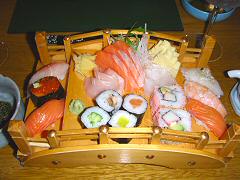 We kicked off the meal with a bit of sushi – sharing the combo sushi platter, which comes with a nice array of different fish, and, I think the first time I’ve seen it in Buenos Aires, ikura, or salmon eggs. The sushi menu also lists uni, the love it or hate it butterscotch pudding textured and colored sea urchin roe, but they didn’t have any in house last night – they must have it relatively often as our waitress had to go ask if there was any available for the evening. The sushi combo is presented very prettily on a small wooden bridge… the one drawback to sharing it is that it’s designed as a one person main course,
We kicked off the meal with a bit of sushi – sharing the combo sushi platter, which comes with a nice array of different fish, and, I think the first time I’ve seen it in Buenos Aires, ikura, or salmon eggs. The sushi menu also lists uni, the love it or hate it butterscotch pudding textured and colored sea urchin roe, but they didn’t have any in house last night – they must have it relatively often as our waitress had to go ask if there was any available for the evening. The sushi combo is presented very prettily on a small wooden bridge… the one drawback to sharing it is that it’s designed as a one person main course, 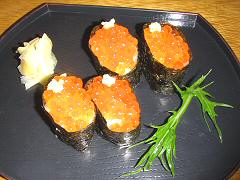 and most of the items on it are presented as single pieces… we did the back and forth “you pick one” and then “I’ll pick one” routine. The ikura was such a treat that we decided to order another round… not an inexpensive proposition as it turned out at 9 pesos a piece. Overall though, the combo is a decent deal (50 pesos) given the quality of the sushi, which is very good – not quite up to what I had at Yuki a few weeks back, and of course, my thoughts are tainted by truly spectacular sushi had in New York while on vacation, but still quite good.
and most of the items on it are presented as single pieces… we did the back and forth “you pick one” and then “I’ll pick one” routine. The ikura was such a treat that we decided to order another round… not an inexpensive proposition as it turned out at 9 pesos a piece. Overall though, the combo is a decent deal (50 pesos) given the quality of the sushi, which is very good – not quite up to what I had at Yuki a few weeks back, and of course, my thoughts are tainted by truly spectacular sushi had in New York while on vacation, but still quite good.
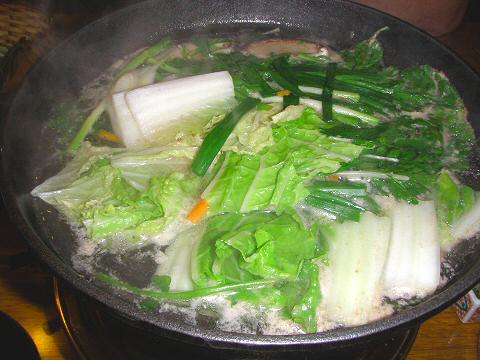
Nihonbashi offers a choice of two different types of beef for your dipping pleasure… straightforward Argentine beef, and Argentine raised Wagyu beef, the famed Japanese cattle that are raised to provide Kobe beef. [A note: last year, in November, in a financial protectionist move (however, claiming cultural reasons), the Japanese Ministry of Agriculture declared that Wagyu wasn’t just a designation of the breed of cattle, but also indigenous to Japan, and that although for years the Japanese have been selling the cattle to overseas ranchers, they didn’t want anyone outside Japan ever using the term Wagyu again. The rest of the world, unsurprisingly, has simply ignored this declaration.] These two photos should offer up a sense of the difference in the beef – the Wagyu, on the right, showing the “marbling” of fat that it’s famous for.
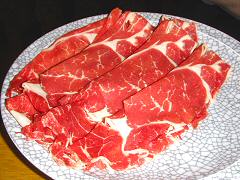
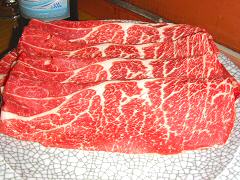
[…] taking the place of some cool little neighborhood café), yet with two exceptions – Yuki and Nihonbashi – I’ve never seen salmon eggs here, and certainly not available retail. Well, I’ve […]
Returned to this spot the other night with another friend. This time we kept our spending, and stuffing ourselves, urges more in check and it really isn’t that bad. We had a round of iichiko, which is a barley-based spirit with a flavor similar to cold sake to start, and a half-liter flask of sake to go with dinner. We ordered one sushi roll and one tempura plate, and our waitress suggested that rather than the shabu-shabu for two, we get it for one, and if we wanted more meat, just order an extra plate of meat rather than pay for it upfront along with a second basket of veggies. Smart move – you really don’t need a double sized basket of veggies, and in the end, we didn’t need either the extra plate of meat, nor the offered noodle addition at the end. Even with price increases we got away for 260 pesos combined (and the tempura racked up 40 by itself). On the other hand, the two guys at the next table over from us, Japanese businessmen, seemed determined to out do each other, and went through two bottles of wine, plus ordered a third and took it with them, appetizers, shabu-shabu for two, plus two extra plates of meat, and the followup noodle soup. Neither of them looked to be in good shape when they left.
Oh, Nihonbashi offers up a Saturday and Sunday special – a shabu-shabu for the table with unlimited meat for a flat price per person, and it also includes dessert. Apparently a very popular family day.
[…] plates of raw fish and rice. And there have been successes, and glimmers of hope – Yuki, Nihonbashi, Comedor Nikkai, Maki… but mostly it’s been lackluster, mediocre, and all that salmon […]
[…] I’ve never figured that out, but it’s only at the real Japanese run spots like Yuki, Nihonbashi or Comedor Nikkai that you can get nigiri sushi served by the piece and I don’t understand […]
[…] for delivery, Maki Sushi, and while it may not top a special evening out at somewhere like Yuki or Nihonbashi, even at its Recoleta prices (dinner for two ran us 233 pesos) it’s around half the cost of […]
[…] of Once, or Balvanera barrio, but they are among the most traditional in the city – Yuki, Nihonbashi, Shogun, Sashimaya (which doesn’t have ramen, but I’ll get to at some point), and […]
[…] been a few years since I dropped in to Nihonbashi, Moreno 2095 in Congreso, and even more since I originally reviewed it, way back in 2007. It’s the sort of place that requires pulling out a credit card that has a […]